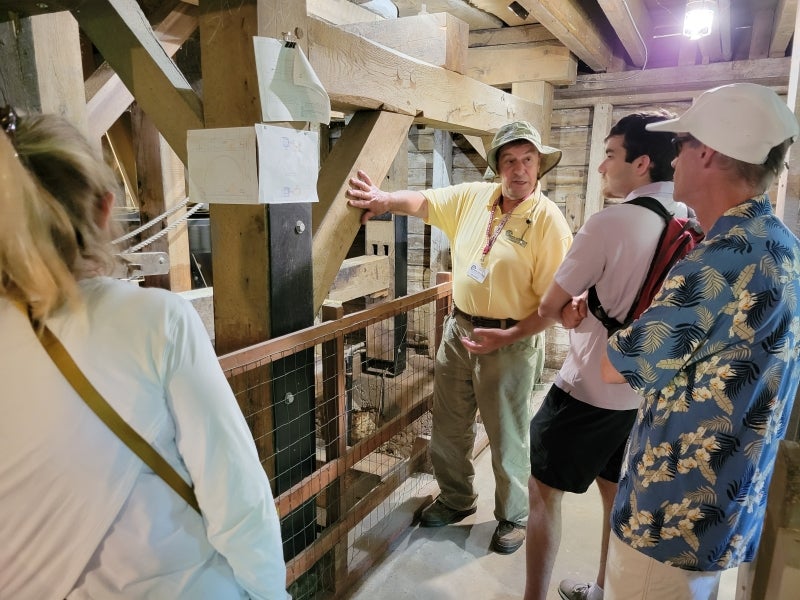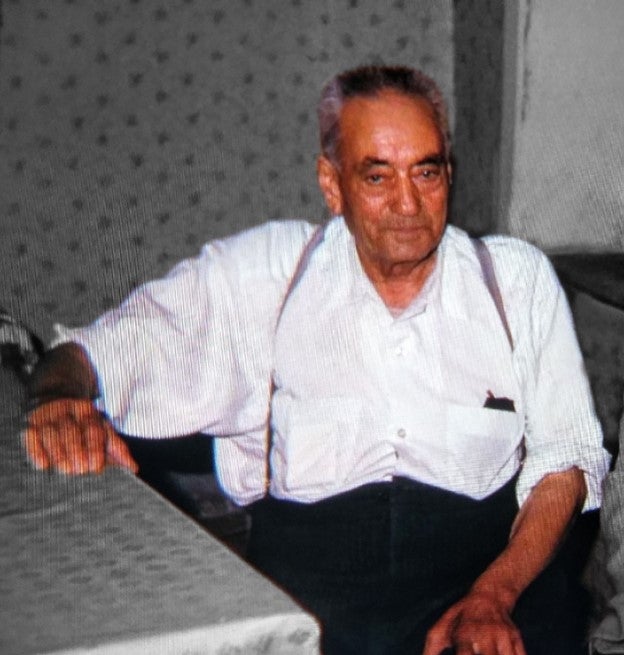Blog


Gino Caporizzo’s large, tanned hand pats a wood beam inside the historic Springfield Mills at Bloomfield Farm. The tour group he’s leading learns very quickly why he touches it so lovingly.
“My father and grandfather were millers,” he says proudly, his accent hinting at his heritage in southern Italy.
Caporizzo has been a volunteer guide and maintenance worker at Springfield Mills at Morris Arboretum & Gardens for about five years. But his kinship with mills goes back to before World War I with his grandfather, Luigi Caporizzo, who in his mid-20s became an apprentice at one of two grist mills in his hometown of Paternopoli in the province of Avellino, Campania.

“When the war broke out, he went into the service, and when he came back he became a partner in the grist mill,” said Caporizzo. Powered by water from the nearby river, the mill ground wheat and corn for local residents. Once electricity became available, the mill was moved close to the center of town, but the millstone technology was still used to grind grains and corn as well as acorns for animal feed. Luigi Caporizzo’s typical workday started early in the morning. He labored at the mill until midday, then worked alongside his family on one of two farms they owned.
As Gino Caporizzo takes visitors through the 1761 mill situated along the Wissahickon Creek, his thoughts aren’t far from his father and grandfather and their vocation that taught him so much.
NEXT GENERATION
“My dad, Mario, became an apprentice and a helper for his dad,” said Gino. “As a teenager, he would help his dad at the mill after school.” Caporizzo remembers both men as being close to 6 feet tall and able to lift burlap sacks of grains weighing more than 100 pounds with ease.
During World War II, Mario Caporizzo fulfilled his military duties by working as a miller while stationed in Verona and Caserta. When he returned to Paternopoli, he took on the daily operation of the mill, allowing his father to pull back from the business. Mario oversaw the construction of a new mill that incorporated a steel roller mill along with the two millstones bays.
Mario did all of the maintenance work himself, including sharpening the millstones, known as “dressing.” It was a dangerous process with flying shards of stone and metal, and Mario wore safety glasses and no gloves, Gino recalled.
“Both my father and grandfather could point out the shards embedded in their hands,” Gino said. “My father would often say it was the price that one would pay for being a miller.”
Gino was introduced to the job of milling in his early teens. His father would hand him the keys and send him to help customers who showed up after hours.
“My father had very specific instructions. You had to weigh the grains. Write in the ledger the amount of wheat and also the date,” he said. “On normal business days, most customers would wait as their grain was milled.”
CREATING A NEW LIFE
Eventually, milling could not sustain Mario Caporizzo’s growing family, so he brought them to the US in 1963, when Gino, the oldest of four children, was 13. Gino tears up as he tells this part of the story.

“You know, the struggle that he was faced with, and at times I would put myself in his own shoes,” he said. “You come here at 42 years old, without having specialized type of work, but as a miller, right? Where are you going to go, what are you going to do? You had nothing and you start from scratch. It’s a subject that is very dear to me.”
Mario became a construction worker and then a stonemason. He made it clear to his children that they needed to do their best in school.
“For me, high school was a little bit tough, but I stuck to the guns and pursued my dream,” he said. “I will always carry this famous loving quote from him. When he talked to all four kids, he would say, ‘Remember, we did not come here for a change of air.’ That line has been with me and the rest of the family since that day.”
Gino earned an electrical engineering degree from Drexel University and has worked in the telecommunications industry for more than 35 years. His siblings all have college degrees as well, something Mario was very proud of.
“At times during a family dinner, he would often share his thoughts,” said Gino, “and he would quietly say, ‘Looks like we made it.’”

FEELING AT HOME
The time he spent as a miller was never far from Mario’s mind.
“Any place that we went, he always looked for mills,” said Gino. A favorite spot was Nolt’s Mill in Bird-in-Hand in Lancaster County, Pa. “We always think of the time that my dad went inside and said he felt at home.”
Gino Caporizzo has expanded his knowledge of mills in this area and enjoys being a member of both the Society for the Preservation of Old Mills (SPOOM), and of TIMS—The International Molinological Society, the only organization dedicated to mills on a worldwide scale. Molinology is the study of mills and other devices that use energy for mechanical purposes such as grinding or sawing. Gino met Morris mill volunteers at a local SPOOM event.
“Whenever we do work at the Springfield Mills, I always keep thinking to myself if my father was here, he would have enjoyed this,” he said.
Gino Caporizzo looks to his roots for his successes today.
“Growing up, I respected and valued my father’s work ethic, patience, and persistence, and they quickly became the foundations of my aspirations,” he said. “Today, everything that I have been able to accomplish is due to being the son of a miller.”